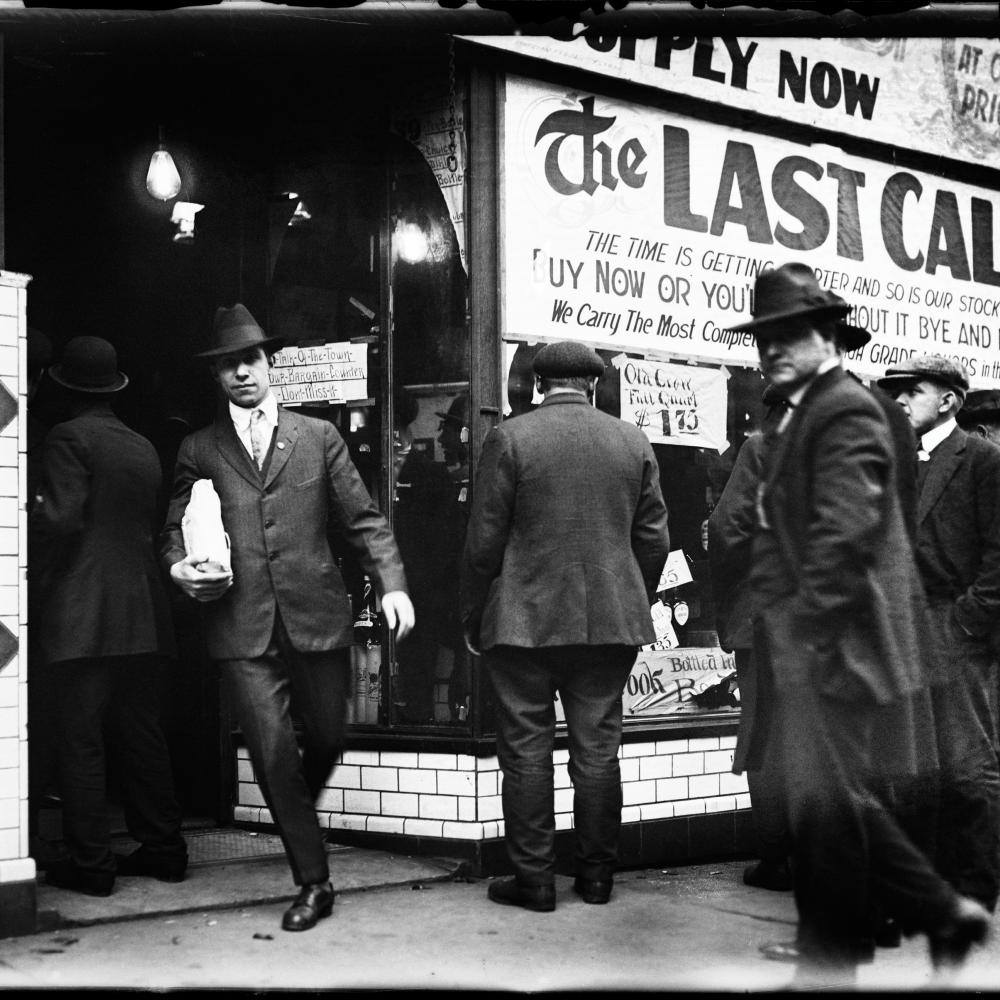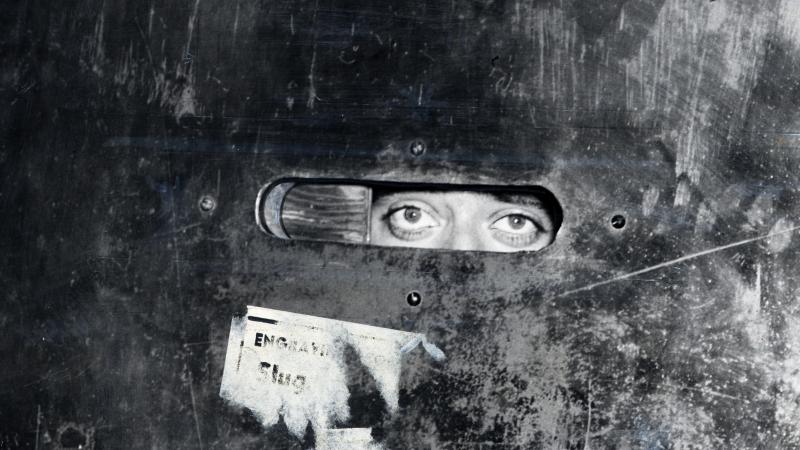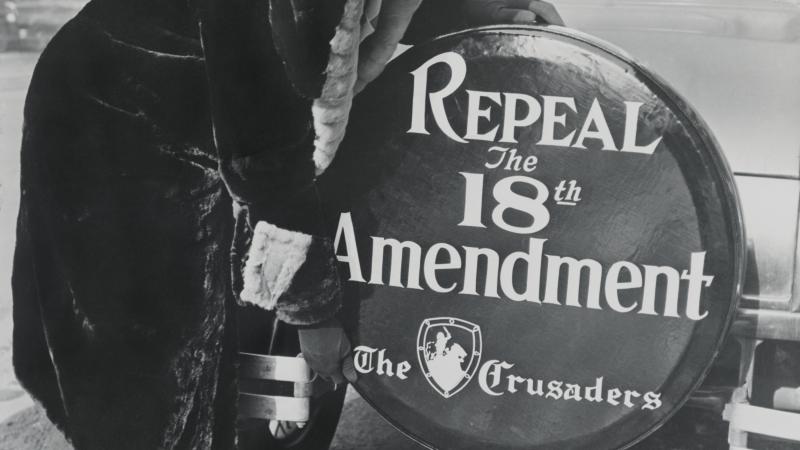Americans have long been in love with the Jazz Age, and who can blame us? The Great Gatsby. Al Capone. The Charleston. Louis Armstrong. Flappers. Speakeasies. As F. Scott Fitzgerald said, it was when the United States came into its own, and could determine for itself “what was fashionable and what was fun.”
We may be easily drawn to romanticized images of the 1920s, but we cannot let our collective fascination with bathtub gin, gangsters, and jazz clubs cloud our vision of the Prohibition era. There were very serious matters at the heart of the debates surrounding the legislation that ushered in the period. With the broadcast this October of Ken Burns and Lynn Novick’s three-part documentary Prohibition, Americans will get a chance to rethink that era’s meaning.
What the film makes clear is that Prohibition was the first of the many “culture wars” that would divide the United States in the twentieth century. Before the debates about abortion, gay marriage, gun rights, school prayer, or the legalization of marijuana—all issues that put the rights of the individual in conflict with the demands of society or the state—the nation argued over prohibition. At the heart of the discussions were these questions: What are the limits of social reform? What are the consequences when reform goes too far? What are the limits of government, especially when it comes to how we conduct our private lives? Clearly, there was much more at stake here than booze.
Nineteenth-century Origins of the Alcohol Debate
Burns and Novick place this debate within a broader history of alcohol use and abuse in American history. The Prohibition experiment, in their eyes, was not the product of a sudden, naïve push for a ban on alcohol in the 1920s, but instead was rooted in a much longer debate over alcohol and social behavior extending back to the early nineteenth century. Best estimates indicate that Americans in the early nineteenth century drank three times as much alcohol as their descendants do today.
The prevalence of alcohol in daily life was plainly visible. Prohibition opens with the observations of Frederick Marryat, an English captain who noted in 1839:
The Americans can fix nothing, without a drink. If you meet, you drink; if you part, you drink; if you make acquaintance, you drink; if you close a bargain, you drink; they quarrel in their drink, and they make it up with a drink. They drink, because it is hot; they drink because it is cold. If successful in elections, they drink and rejoice; if not, they drink and swear; they begin to drink early in the morning, they leave off late at night; they commence it early in life, and they continue it, until they soon drop into the grave.
Had Marryat accepted every drink he was offered, he complained, he would have not been “sober for three or four weeks at a time.”
As the consumption of distilled spirits increased, American fondness for drink caused clear problems: domestic violence, crime, neglected families, economic ruin, disease, and death. It was these combined effects of alcohol abuse that led
reformers to warn against “demon rum.”
This context is important for understanding why the seemingly preposterous idea of prohibiting the manufacture, sale, and transportation of alcohol nationally through a constitutional amendment gained traction as the nineteenth century came to a close. Nothing else had worked. Waves of temperance reformers, including the famed pastor Lyman Beecher, and temperance groups like the Washingtonians, had tried to reform drinkers through moral suasion and by promoting voluntary abstinence, but those who believed that moral fortitude and personal resolve could conquer alcoholism were quickly disappointed.
The early temperance wave that swept the United States in the 1830s and 1840s proved to be exactly that—a wave. The moral urgency behind temperance was soon eclipsed by the other great moral concern of the time: the abolition of slavery. The Civil War proved the undoing of the early temperance movement. As Americans focused on the most urgent issue of the time, and then turned to alcohol to soothe the pains of war, the first wave of temperance activity receded.
Legislating Morality
The next wave of reform, the one that ultimately brought Prohibition to the United States, was a very different movement. Reformers no longer emphasized temperance and voluntary abstinence, but prohibition through legislation.
For whatever reason, the popular imagination often attributes Prohibition to the work of women, such as Carry A. Nation, whose famed “hatchetations” terrorized saloon owners in Kansas for a brief period in the early 1900s. She brought attention to the movement, but achieved little beyond creating a spectacle. The Woman’s Christian Temperance Union, which pledged to “do everything” to root out the use of alcohol in the United States, also achieved less than its reputation suggests. It galvanized women’s support for Prohibition, and opened the doors to political activity for millions of women, but accomplished little to move the nation toward a ban on alcohol.
It fell to the Anti-Saloon League, an organization once known to every American, to spearhead the effort that ushered in the Eighteenth Amendment and the Volstead Act. The result was a failed Prohibition experiment that lasted thirteen years, ten months, and nineteen days.
Formed in Oberlin, Ohio, in 1893, the Anti-Saloon League was in many ways the forerunner of the modern, single-issue lobbying organization. At the turn of the twentieth century, it was a fearsome power in American politics. The league was no modest volunteer organization—with funding from John D. Rockefeller and contributions from tens of thousands of American churches, the league was structured like a corporation, and staffed by lawyers, statisticians, publicists, fundraisers, and researchers. It used modern advertising techniques and printed millions of pieces of literature through its wholly owned subsidiary, the American Issue Publishing Company. Its greatest power, however, was found at the ballot box.
Unlike its predecessors, the Anti-Saloon League never fielded its own candidates for elected office. Instead, it mobilized thousands of voters to sway elections. In Ohio, the league targeted seventy legislators who opposed the dry agenda and managed to drive them all from office, before turning its sights on Governor Myron Herrick. By the time its campaign helped defeat Herrick in 1905, the league had established itself as a national presence. Party affiliation and the drinking habits of individual politicians made no difference to the league—it simply supported candidates who backed the campaign for Prohibition, and it campaigned mercilessly against those who opposed it.
The Anti-Saloon League spent the first decade of the twentieth century perfecting the art of what a political scientist of the time, Peter Odegard, called “pressure politics.” It lobbied elected officials to commit for or against prohibition. Opponents of the league could expect to be attacked in the dry press, bombarded with telegrams, have their personal lives probed by private investigators, and have rumors about their political and financial affairs floated in public.
Its president, Wayne B. Wheeler, became one of the most feared men in American politics. A biographer unabashedly declared that in his lifetime, Wheeler “controlled six Congresses, dictated to two Presidents of the United States, directed legislation in most of the States of the Union . . . and was recognized by friend and foe alike as the most masterful and powerful single individual in the United States.” In New York, his deputy, William H. Anderson, was equally feared. Anderson bragged of his “hard hitting and merciless fighting,” which is to say, bullying, intimidation, and insinuation. The mention of his name was enough, according to one New York official, to “make your blood run cold and your hair stand up.” (And this from a moderate dry politician Anderson had targeted for not being dry enough.)
Pressure Politics
The Anti-Saloon League’s reputation as a force in American politics was well deserved. It set clear legislative goals, and it met them, often steamrolling a weak and disorganized wet opposition. The league’s strategy was straightforward. It sought first to dry up towns and counties by promoting “local option” laws that allowed voters to ban alcohol sales and saloons, in particular, on a district-by-district basis. Under this campaign, nearly half the area of the United States went dry by 1913. In New York alone, league efforts had increased the number of dry towns from 276 to 400, and entire states like Colorado, Oregon, Utah, Washington, and Nevada had gone dry as well. Cities proved the hardest targets, with their proliferation of working-class saloons and recent immigrants, but the Anti-Saloon League saw victories in cities like Birmingham, Worcester, and Berkeley, where if the alcohol trade was not outlawed outright, it was restricted.
Incremental gains were all it took to keep the league advancing towards its ultimate goal: national prohibition. Calls to curb the abuse of alcohol by closing the saloon overlapped with Progressive efforts to improve public health and welfare. Demands for “good government” and municipal reform went with dry efforts to purge the influence of saloon owners in urban politics. Campaigns to regulate the location and business hours of saloons meshed with efforts to use zoning to regulate the chaos of the growing American city. Efforts to curb the power of the distilling and brewing industries, dominated by a few large monopolies, went hand in hand with efforts to regulate other monopolies like oil and meat. It is no coincidence that the Anti-Saloon League referred to its proposals as “distinctly progressive” legislation.
The breadth of the Progressive movement made for unlikely, but effective, allies. Because of the sweeping influence of Progressivism, the league could count on support from allies as disparate as labor unions, industrialists, settlement house reformers, and African-American leaders, all of whom could find some reason to support Prohibition.
"Booze or Coal"
The final push for Prohibition, however, was rooted in World War I. Without the U.S. entry into the war, it is unlikely Prohibition would have ever come to fruition. To the Anti-Saloon League, the war presented the ultimate opportunity to manipulate its message to address the national emergency, and it did so in brilliant ways. Calls for sacrifice for the sake of a nation at war were echoed by dry calls to conserve grain for food. The league circulated propaganda that asked for “Booze or Coal?” Patriotism, the league insisted, meant Americans should give up drink to support soldiers who were giving up their lives. In New York, the wettest of wet strongholds, a 1:00 AM curfew was approved with the rationale that it “is a late enough bedtime for a people who are awaiting the summons to war.”
The charged climate of wartime made it difficult for anyone to challenge the Anti-Saloon League’s assertion that Prohibition and patriotism were one in the same. With the Anti-Saloon League loudly proclaiming, “The challenge to loyal patriots of America today is to demand the absolute prohibition of the liquor traffic,” those who had reservations about Prohibition swallowed their opposition for fear of appearing disloyal.
The league was particularly insistent in its blunt reminders of the connections between the brewing industry and Germans. In 1917, one Anti-Saloon League publication crowed, “German brewers in this country . . . have rendered thousands of men inefficient and are thus crippling the Republic in its war on Prussian militarism.” Another league pamphlet spoke out against “the un-American, pro-German, crime-producing, food-wasting, youth-corrupting, home-wrecking, treasonable liquor traffic.” Raising the specter of sabotage and alien infiltration, another prohibitionist publication declared, “We have German enemies in this country too.” Reciting the names of the country’s prominent brewing companies, it noted, “the worst of all . . . are Pabst, Schlitz, Blatz, and Miller.”
In a climate where anyone who dared oppose Prohibition risked being branded a traitor, the Anti-Saloon League used the war to win a series of increasingly strict anti-alcohol measures. The first came in August 1917 with Asbury F. Lever’s Food and Fuel Control Act, a wartime measure that gave President Woodrow Wilson broad powers to regulate the nation’s food supply. It banned the use of grain for distilling and restricted wine and beer production for the duration of the war. Then came the Wartime Prohibition Act, a temporary federal measure enacted in November 1918, which barred the manufacture of beer and wine in the United States after May 1919, and prohibited the sale of beverages containing more than 2.75 percent alcohol anywhere in the nation after July 1, 1919. By the time Nebraska became the thirty-sixth state to ratify the Eighteenth Amendment on January 16, 1919, giving it the three-fourths majority necessary for enactment, many Americans were already experiencing the gradual implementation of the dry experiment. The league’s final victory was the passage of the Volstead Act, the federal law enforcing Prohibition. Its severity caught many Prohibition supporters off guard, leaving them wondering what they had signed up for.
Stepping Over the Line
While World War I had given the Anti-Saloon League the opportunity to ensure the ratification of the Eighteenth Amendment, it had taken advantage of that opportunity at great cost. The dry victory over the saloon had been won by aggressive lobbying, opportunistic use of the Progressive movement and the war, and finally by demonizing all who opposed Prohibition. Not only Germans, but Italians, Irish, Jews, and other recent immigrants from Southern and Eastern Europe felt distinctly singled out by the Prohibitionists. Anti-Saloon League figures like William Anderson and James Cannon Jr., bishop of the Methodist Episcopal Church, further inflamed matters with disparaging remarks about Catholics.
Prohibition went into effect exactly at the time when American cities began to hold the majority of the American population. In those cities, where support for Prohibition was tentative at best, there was a strong sense that the dry agenda was intended, first and foremost, to clean up, reform, and punish the American city-dweller. There was also a strong sense that “anti-saloonism” was born of the middle class and designed to target the working class. In 1919, the future mayor of New York City and staunch opponent of Prohibition, James J. Walker, reduced Prohibition to a campaign “to take a glass of beer away from the workingman while allowing the rich to have their cellars filled with wine.” To Walker, Prohibition embodied the anxiety within the dry movement about the changing identity of the American people. Immigration and urbanization had transformed the United States within a generation, and Prohibition was as much a desperate effort to resist inevitable changes as it was an attempt to curb the abuse of alcohol.
The increasingly vitriolic rhetoric of the dry movement made it impossible for American city-dwellers to see it any other way. With the enactment of Prohibition, the Progressive language that had brought allies to the Prohibition campaign now gave way to increasing examples of anti-immigrant and anti-Catholic sentiment and scapegoating. For those who had come to the United States fleeing oppression, Prohibition brought the painful realization that a new form of oppression was being enacted in the United States at the hands of the dry lobby. The simple act of drinking a glass of wine now not only made one a criminal, but also called into question one’s patriotism and fitness to be an American. Imagining how refugees who had fled Europe in search of freedom might view the dry experiment, the Irish World asked, “Will they, who have come here from under a rule which oppressed them in so many things but left them free [to drink], . . . still think of America as the land of personal liberty and human equality?”
The question suggests that the final arrival of Prohibition in January 1920 marked both victory and defeat for the dry lobby. The enactment of the Prohibition amendment had been the result of a well-funded, well-organized, and tireless campaign by the Anti-Saloon League, a pioneering lobby that attacked its foes, silenced its critics, and built alliances of opportunity that had allowed drys to alter the Constitution to suit their vision of the United States. Theirs was an astonishing victory, but one that in all likelihood would have fallen short had it not been for the timely arrival of World War I and its masterful exploitation by the Anti-Saloon League. But the Anti-Saloon League had failed to see the costs of its strategy. Having pushed Constitutional reforms through pressure politics, the league set the stage for a spectacular wave of resistance to the reforms it had imposed on the nation, and for the dramatic failure of its own agenda.




